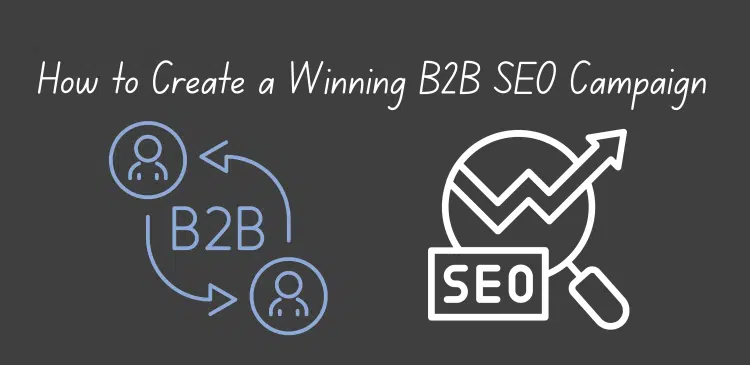How to Create a Winning B2B SEO Campaign

Creating a successful B2B SEO campaign involves several strategic steps that can significantly enhance your online presence. Start by conducting thorough keyword research to identify the terms your target audience is searching for. Next, optimize your website’s content and structure to ensure it aligns with these keywords. Don’t forget the importance of building high-quality backlinks and engaging with your audience through valuable content. Finally, monitor your campaign’s performance and make adjustments as needed to achieve the best results. With the right approach, your B2B SEO campaign can lead to increased visibility and growth
Tips to Create a Winning B2B SEO Campaign:
- Define Your Goals and KPIs
Setting goals and objectives for your SEO is essential before categorizing the various types of SEOs available in the market. Are you seeking organic traffic, improved conveyance, or simply enhanced brand visibility? Determine key metrics that will help in monitoring the achievement of established goals and objectives. This can include various aspects such as important roles of certain terms, the number of visitors coming to your site naturally, leads generated, or even the duration of time that visitors engage with your website.
- Conduct In-Depth Keyword Research
The next step in any effective SEO strategy is conducting thorough keyword research. You can also discover keywords with tools like Google Keyword Planner, SEMrush, and Ahrefs. Following that, we can anticipate the common inquiries that clients tend to pose and the way they articulate them. This will allow you to address the concerns your audience may have and what they are actively looking for.
3. Understand Your Audience
Understanding your audience is essential in B2B marketing. Additionally, collect information on demographics, key issues, objectives, and the behaviors of your target audience. Understanding this will help you create the right content that captures the attention of different stakeholders engaged in decision-making across various industries.
- Optimize for Intent
B2C often revolves around product features and the advantages gained from various purchases, whereas B2B inquiries tend to follow a more procedural approach. Therefore, your content must fulfill these objectives by providing top-notch expertise, case studies, comprehensive reports, and practical guides that empower marketers to make informed choices.
- Develop High-Quality, Relevant Content
Content continues to reign supreme in modern SEO strategies, as it serves as the primary focus for users seeking information or services on the internet. Deliver content that is relevant and informative, while also providing clear guidance to address user’s inquiries. These can take the shape of various formats, including articles, research papers, digital books, online seminars, and visual content. Regularly updating content is essential to keep the audience engaged and encourage them to return for more.
- Optimize On-Page SEO
On-page SEO, often called on-site optimization, involves modifying elements of a particular web page to enhance its ranking in search results. This involves enhancing the title tags, meta tags, header tags, and image tags with suitable keywords. Ensure that the URLs are free of special characters and clearly convey the content they represent. Internal links play a crucial role in your website’s structure. They connect various pages within your site, helping search engines comprehend your layout and the ranking strategies you’ve implemented.
- Leverage Technical SEO
Technical SEO enhances your website’s readability and ensures it can be effectively indexed or cataloged by search engines. Improving site speed, ensuring a mobile-friendly design, creating an XML sitemap, and implementing structured data (schema markup) are essential steps to enhance search engine visibility. Regularly check your site for issues like 404 errors, URL redirections, and other errors.
- Create Valuable Backlinks
When it comes to building backlinks, there are several effective techniques that are particularly beneficial for B2B businesses. High-quality links from reputable sites play a crucial role in enhancing your site’s ranking. They signal to search engines that your content is highly relevant and valuable. Connect with industry leaders, contribute guest posts to reputable websites, and create research and infographics that are likely to attract clicks and links. Using unethical techniques is no longer acceptable, as they can result in penalties from search engines.
- Enhancing Local SEO
For B2B businesses aiming at specific geographic areas, local SEO is crucial. Ensuring your Google My Business listing is properly aligned involves verifying your NAP information—Name, Address, Phone number—and actively collecting reviews.
- Content Marketing & Brand Image
Positioning a company as a thought leader in its industry can bring significant advantages, especially when it comes to SEO. Create unique articles, engage in industry discussions, and attend conferences. Collaborate with various types of websites to share articles that can be featured on each other’s platforms. In addition to boosting authority, thought leadership attracts links from other websites that reference the relevant content.
- Monitor and Adjust Your Strategy
It’s important to recognize that SEO is a continuous journey that requires regular management and adjustments as time goes on. Monitor your progress by utilizing targeted analytics from Google Analytics and Google Search Console to identify areas that require improvement. Identify the keywords that attract the highest number of visitors to the website, determine which pages are the most popular, and analyze where users are most likely to exit the site. It’s important to periodically assess your performance and adjust your strategies to align with your goals.
- Prioritize User Experience (UX)
User experience is essential for encouraging visitors to stay engaged and ultimately make a purchase or sign up. Create a visually appealing and user-friendly website that provides the information customers seek. A positive user experience can significantly influence a lower bounce rate and extend the time users spend on the website, ultimately benefiting SEO efforts.
- Leverage Social Media
While some argue that social media signals don’t impact SEO rankings, they undeniably play a role in sharing information and guiding visitors to your website. Therefore, it’s essential to share your content on the right social profiles and engage with your followers. By doing this, you enhance the likelihood that your content will be shared and that others will link to it too.
- Stay Updated on the Latest SEO Developments and Algorithm Changes
Staying updated with the latest trends and changes is essential. Engaging with blog articles about the industry, attending webinars, and participating in SEO forums can greatly enhance your knowledge and skills.
